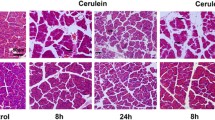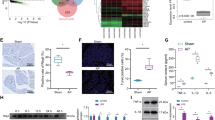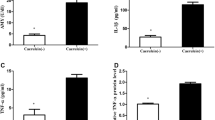Abstract
Background
Acute pancreatitis (AP) is an inflammatory process of the pancreas resulting from biliary obstruction or alcohol consumption. Approximately, 10–20% of AP can evolve into severe AP (SAP). In this study, we sought to explore the physiological roles of the transcription factor serum response factor (SRF), annexin A2 (ANXA2), and nuclear factor-kappaB (NF-κB) in SAP.
Methods
C57BL/6 mice and rat pancreatic acinar cells (AR42J) were used to establish an AP model in vivo and in vitro by cerulein with or without lipopolysaccharide (LPS). Production of pro-inflammatory cytokines (IL-1β and TNF-α) were examined by ELISA and immunoblotting analysis. Hematoxylin and eosin (HE) staining and TUNEL staining were performed to evaluate pathological changes in the course of AP. Apoptosis was examined by flow cytometric and immunoblotting analysis. Molecular interactions were tested by dual luciferase reporter, ChIP, and Co-IP assays.
Results
ANXA2 was overexpressed in AP and correlated to the severity of AP. ANXA2 knockdown rescued pancreatic acinar cells against inflammation and apoptosis induced by cerulein with or without LPS. Mechanistic investigations revealed that SRF bound with the ANXA2 promoter region and repressed its expression. ANXA2 could activate the NF-κB signaling pathway by inducing the nuclear translocation of p50. SRF-mediated transcriptional repression of ANXA2-protected pancreatic acinar cells against AP-like injury through repressing the NF-κB signaling pathway.
Conclusion
Our study highlighted a regulatory network consisting of SRF, ANXA2, and NF-κB that was involved in AP progression, possibly providing some novel targets for treating SAP.





Similar content being viewed by others
Abbreviations
- AP:
-
Acute pancreatitis
- MAP:
-
Mild acute pancreatitis
- SAP:
-
Severe acute pancreatitis
- LPS:
-
Lipopolysaccharide
- ATCC:
-
American type culture collection
- FBS:
-
Fetal bovine serum
- QNZ:
-
Quinazoline
- ELISA:
-
Enzyme-linked immunosorbent assay
- IL-1β:
-
Interleukin-1β
- TNF-ɑ:
-
Tumor necrosis factor-ɑ
- HE staining:
-
Hematoxylin and eosin staining
- TUNEL staining:
-
TdT-mediated dUTP-biotin nick end-labeling staining
- ChIP:
-
Chromatin immunoprecipitation
- FITC:
-
Fluorescein isothiocyanate
- PBS:
-
Phosphate-buffered saline
- DAPI:
-
4′,6-Diamidino-2-phenylindole
- cDNA:
-
Complementary DNA
- qRT-PCR:
-
Quantitative real-time polymerase chain reaction
- SDS-PAGE:
-
Sodium dodecyl sulfate–polyacrylamide gel electrophoresis
- ANOVA:
-
One-way analysis of variance
References
Tang GX, et al. MiR-20b-5p modulates inflammation, apoptosis and angiogenesis in severe acute pancreatitis through autophagy by targeting AKT3. Autoimmunity. 2021;54(7):460–70.
Boxhoorn L, et al. Acute pancreatitis. Lancet. 2020;396(10252):726–34.
Banks PA, et al. Classification of acute pancreatitis–2012: revision of the Atlanta classification and definitions by international consensus. Gut. 2013;62(1):102–11.
Trikudanathan G, et al. Current concepts in severe acute and necrotizing pancreatitis: an evidence-based approach. Gastroenterology. 2019;156(7):1994-2007.e3.
Maheshwari R, Subramanian RM. Severe acute pancreatitis and necrotizing pancreatitis. Crit Care Clin. 2016;32(2):279–90.
Munir F, et al. Advances in immunomodulatory therapy for severe acute pancreatitis. Immunol Lett. 2020;217:72–6.
Christensen MV, et al. Annexin A2 and cancer: a systematic review. Int J Oncol. 2018;52(1):5–18.
Dallacasagrande V, Hajjar KA. Annexin A2 in inflammation and host defense. Cells. 2020;9(6):1499.
Zhang S, et al. Annexin A2 binds to endosomes and negatively regulates TLR4-triggered inflammatory responses via the TRAM-TRIF pathway. Sci Rep. 2015;5:15859.
Zhao D, et al. The interaction between ANXA2 and lncRNA Fendrr promotes cell apoptosis in caerulein-induced acute pancreatitis. J Cell Biochem. 2019;120(5):8160–8.
Kalita K, Kuzniewska B, Kaczmarek L. MKLs: co-factors of serum response factor (SRF) in neuronal responses. Int J Biochem Cell Biol. 2012;44(9):1444–7.
Miano JM. Role of serum response factor in the pathogenesis of disease. Lab Invest. 2010;90(9):1274–84.
Miralles F, et al. Conditional inactivation of the murine serum response factor in the pancreas leads to severe pancreatitis. Lab Invest. 2006;86(10):1020–36.
Zhou X, et al. Socs1 and Socs3 degrades Traf6 via polyubiquitination in LPS-induced acute necrotizing pancreatitis. Cell Death Dis. 2015;6: e2012.
Zhao Q, et al. Melatonin attenuates endoplasmic reticulum stress in acute pancreatitis. Pancreas. 2018;47(7):884–91.
Murphy AJ, Guyre PM, Pioli PA. Estradiol suppresses NF-kappa B activation through coordinated regulation of let-7a and miR-125b in primary human macrophages. J Immunol. 2010;184(9):5029–37.
Demols A, et al. Endogenous interleukin-10 modulates fibrosis and regeneration in experimental chronic pancreatitis. Am J Physiol Gastrointest Liver Physiol. 2002;282(6):G1105–12.
Jacob TG, et al. Duration of injury correlates with necrosis in caerulein-induced experimental acute pancreatitis: implications for pathophysiology. Int J Exp Pathol. 2014;95(3):199–208.
Deng YW, Shu YG, Sun SL. LncRNA PART1 inhibits glioma proliferation and migration via miR-374b/SALL1 axis. Neurochem Int. 2022;157:105347.
Joy M, et al. The myocardin-related transcription factor MKL co-regulates the cellular levels of two profilin isoforms. J Biol Chem. 2017;292(28):11777–91.
Wang Y, et al. Anxa2 gene silencing attenuates obesity-induced insulin resistance by suppressing the NF-kappaB signaling pathway. Am J Physiol Cell Physiol. 2019;316(2):C223–34.
Ismail OZ, Bhayana V. Lipase or amylase for the diagnosis of acute pancreatitis? Clin Biochem. 2017;50(18):1275–80.
Defour A, et al. Annexin A2 links poor myofiber repair with inflammation and adipogenic replacement of the injured muscle. Hum Mol Genet. 2017;26(11):1979–91.
Lei Y, et al. Cell-surface translocation of annexin A2 contributes to bleomycin-induced pulmonary fibrosis by mediating inflammatory response in mice. Clin Sci. 2019;133(7):789–804.
Renner B, et al. Annexin A2 enhances complement activation by inhibiting factor H. J Immunol. 2016;196(3):1355–65.
Ma L, Yu Y, Qu X. Suppressing serum response factor inhibits invasion in cervical cancer cell lines via regulating Egr1 and epithelial-mesenchymal transition. Int J Mol Med. 2019;43(1):614–20.
Sisson TH, et al. Inhibition of myocardin-related transcription factor/serum response factor signaling decreases lung fibrosis and promotes mesenchymal cell apoptosis. Am J Pathol. 2015;185(4):969–86.
Dai X, et al. SM22alpha suppresses cytokine-induced inflammation and the transcription of NF-kappaB inducing kinase (Nik) by modulating SRF transcriptional activity in vascular smooth muscle cells. PLoS ONE. 2017;12(12): e0190191.
Xu D, et al. miR-22 contributes to endosulfan-induced endothelial dysfunction by targeting SRF in HUVECs. Toxicol Lett. 2017;269:33–40.
Wang Y, et al. Annexin A2 could enhance multidrug resistance by regulating NF-kappaB signaling pathway in pediatric neuroblastoma. J Exp Clin Cancer Res. 2017;36(1):111.
Scott O, Roifman CM. NF-kappaB pathway and the Goldilocks principle: lessons from human disorders of immunity and inflammation. J Allergy Clin Immunol. 2019;143(5):1688–701.
Hou C, et al. Iguratimod (T-614) attenuates severe acute pancreatitis by inhibiting the NLRP3 inflammasome and NF-kappaB pathway. Biomed Pharmacother. 2019;119: 109455.
Chen X, Song D. LncRNA MEG3 participates in caerulein-induced inflammatory injury in human pancreatic cells via regulating miR-195-5p/FGFR2 axis and inactivating NF-kappaB pathway. Inflammation. 2021;44(1):160–73.
Mo XJ, Ye XZ, Li YP. Effects of euphorbia kansui on the serum levels of IL-6, TNF-alpha, NF-kappaB, sTNFR and IL-8 in patients with severe acute pancreatitis. J Biol Regul Homeost Agents. 2019;33(2):469–75.
Acknowledgements
We would like to give our sincere gratitude to the reviewers for their constructive comments.
All protocols for mouse used and euthanasia followed were approved by the Institutional Animal Care and Use Committee of The Third Xiangya Hospital of Central South University.
Funding
This work was supported by Natural Science Foundation of Hunan Province (No. 2019JJ40472) and Natural Science Foundation of Hunan Province (grant no: 2021JJ40955).
Author information
Authors and Affiliations
Corresponding author
Additional information
Responsible Editor: John Di Battista.
Publisher's Note
Springer Nature remains neutral with regard to jurisdictional claims in published maps and institutional affiliations.
Supplementary Information
Below is the link to the electronic supplementary material.
Rights and permissions
About this article
Cite this article
Tang, G., Yu, C., Xiang, K. et al. Inhibition of ANXA2 regulated by SRF attenuates the development of severe acute pancreatitis by inhibiting the NF-κB signaling pathway. Inflamm. Res. 71, 1067–1078 (2022). https://doi.org/10.1007/s00011-022-01609-8
Received:
Revised:
Accepted:
Published:
Issue Date:
DOI: https://doi.org/10.1007/s00011-022-01609-8




